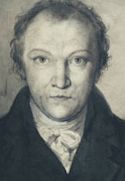
(Click to enlarge)
This watercolor etching was completed in 1794 and now resides at the British Museum
of London as Copy D of only 13 in existence worldwide. The others reside at various
libraries, museums, and universities; and each one is unique because Blake colored
each engraving by hand.
Based on one of the mystical visions he claimed to have experienced and which began when he
was only four years old, The Ancient of Days was one of his favorite engravings.
It depicts the creator of the universe, whom he renamed Urizen, a being who is described by
Wikipedia this way:
“In the complex mythology of William Blake, Urizen is the embodiment of conventional
reason and law. He is usually depicted as a bearded old man; he sometimes bears
architect’s tools, to create and constrain the universe; or nets, with which
he ensnares people in webs of law and conventional society.”
With its vibrant colors of rust and gold, and the crowning touch of blue, Copy D of
The Ancient of Days was chosen as the anchor image during the genesis of
Serving House Journal (SHJ) in 2010. Since then, a copy has resided in the
blue column which appears on each page of the website.
In keeping with SHJ’s commitment to remain non-commercial—which seems
to me to dovetail with Blake’s railings against the artistic, social, and
political status quo(s) of his time—the image is not meant to serve here as
a logo or trademark, but rather as an icon we favor, a visual reminder of a cornerstone
concept. As our founding editor Duff Brenna has said, “God’s compass
inscribing our world” is an essential element of SHJ’s mission. And
perhaps even its raison d’être: “It fits symbolically
with the creative nature of writing. The idea being that writers are little gods
inscribing their own worlds.”
Solomon, son of David and King of Israel, who is credited as the author of the first
nine chapters of The Book of Proverbs, wrote of this divine process of
inscription which inspired Blake and others:
When [the LORD] prepared the heavens, I was there: when he set a compass upon
the face of the depth:
When he established the clouds above: when he strengthened the fountains
of the deep:
When he gave to the sea his decree, that the waters should not pass his commandment:
when he appointed the foundations of the earth[...]
—Chapter 8, verses 27-29, King James Version of The Bible
As a non-conformist and radical thinker, Blake challenged through his poetry and art
that which he despised: the oppressions inherent within the social, political,
artistic, and religous mores of the late 18th century; not only in England and elsewhere
in Europe, but also in North America. The Ancient of Days originally appeared
as the frontispiece of “Europe, A Prophesy,” one of nine illustrated chapters
in Blake’s poem, The [First] Book of Urizen, in which he addresses
“theological tyranny”
(Poets.org, The Academy of American Poets).
In this subversive recreation of the traditional creation story described in The Old
Testament, “the act of creation is itself a fall into the material world, where
flawed creators struggle with each other and with the intractable elements of the cosmos...”
(The William Blake
Archive: About Blake: Biography: 1793-1799: “Illustrated
Books and Separate Prints, 1793-1799,” paragraph 4).
Blake was never well known by the general public; he remained true to his vision—and
to his strange visions—rather than consider compromising in order to become popular.
His work was considered so idiosyncratic and unorthodox that there were few who appreciated
it during his lifetime. For example, some who attended an exhibition of his watercolors at
the Royal Academy in 1808 found his paintings “hideous” and even called him insane
(Poets.org).
Although he experienced critical and public failure as an artist in his later years, The
Ancient of Days, however, was an exception. It was popular enough to generate commissions
for reproductions. To our good fortune, Blake was happy to create several copies of his favorite
engraving, at least a baker’s dozen and each one of them unique, the last of which was
completed only a few weeks before his death in 1827 from gallstones.
|

Detail from self-portrait
(Click image to enlarge)
|
A poet, writer, engraver, and painter who was born in London. The importance of his
work was largely unrecognized during his lifetime, but his prophetic poetry and visionary
art are now considered seminal.
Contemporary critics rank Blake as one of the best poets that Britain has ever produced.
In 2008, The Telegraph released a list of top-ten “perfect poets,”
and Blake’s name was number eight, sandwiched between those of John Milton and
W. B. Yeats.
www.blakearchive.org offers quite a cornucopia of additional details in its biography, “About Blake.”
In addition,
“Works in the Archive” includes electronic versions of 18 of Blake’s books, along with his drawings and paintings.
“
I must Create a System, or be enslav’d by another Man’s...
”
|
|
— William Blake, “The Words of Los,” Line 20, in
Jerusalem: The Emanation of the Giant
Albion
|
|